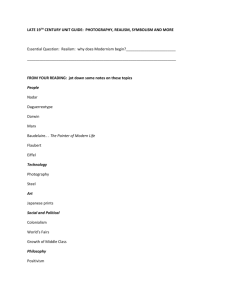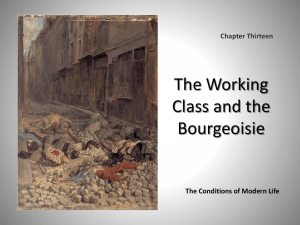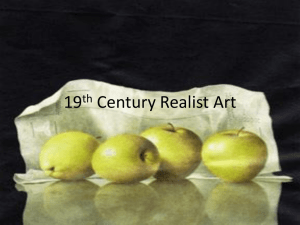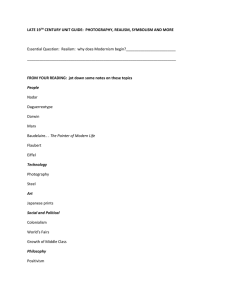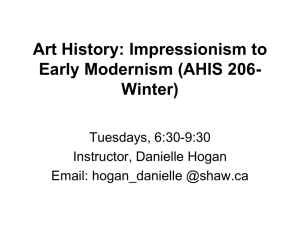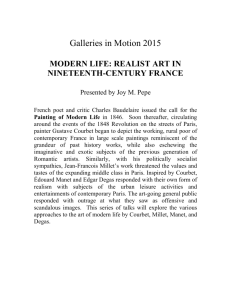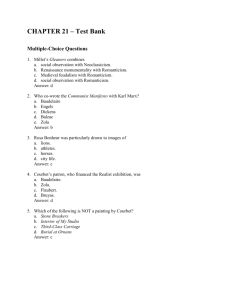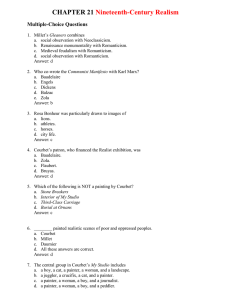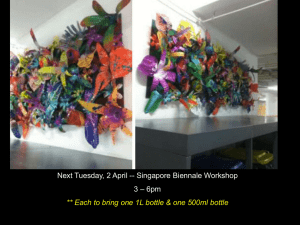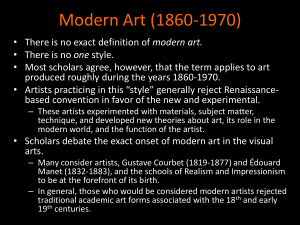Ch 27 Realism - Hawthorne High School
advertisement
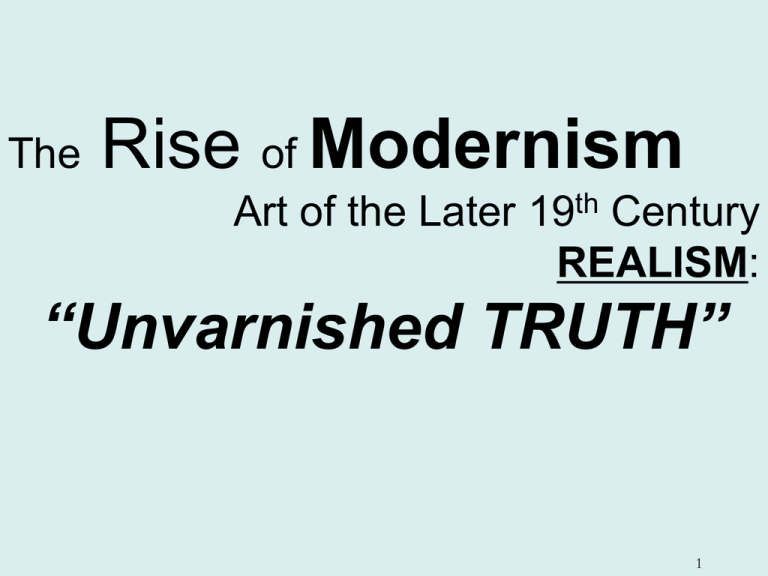
The Rise of Modernism Art of the Later 19th Century REALISM: “Unvarnished TRUTH” 1 Industrialization of Europe and U.S. about 1850 2 Later 19th Century CONTEXT Industrial Revolution: new building materials, social unrest URBANIZATION: cities grew, rural dwellers moved into cities for factory jobs. Emphasis on Science and progress. Empiricism= knowledge based on observation and direct experience Invention of photography REALISM: depicting life as it actually occurs – without myth or glory MODERNISM= deals with present - artists examine the definition and role of art itself- what is Art? Avante Garde= artists rejected past and pushed boundaries 3 Figure 29-1 GUSTAVE COURBET, The Stone Breakers, 1849. Oil on canvas, 5’ 3” x 8’ 6”. Formerly at Gemäldegalerie, Dresden (destroyed in 1945). Gustave Courbet Traits= reevaluation of reality, (Empiricists), shows everyday life. (historical fiction is unobservable, so it is bad), mundane & trivial subjects treated like Grand History painting. - REJECTED by 1855 Salon Show Stone Breakers = lowest of society Style: Not glorified, dirty browns, grays; sense of mechanical monotony Young and old, little sky Context: Revolution of 1848= workers rebel against gov’t = placed workers on center stage Concept: Ind. Rev. invents new machines for new labor, but can’t liberate man from backbreaking work 4 Figure 29-2 GUSTAVE COURBET, Burial at Ornans, 1849. Oil on canvas, approx. 10’ x 22’. Louvre, Paris. 5 REALISM Artist=Millet Barbizon School: images of peaceful country life Gleaners= lowest of society; collect leftovers of the harvest Thought to be a political manifesto How does it fit into the Realist style? Figure 29-3 JEAN-FRANÇOIS MILLET, The Gleaners, 1857. Oil on canvas, approx. 2’ 9” x 3’ 8”. Louvre, Paris. 6 Figure 28-68 TIMOTHY O’SULLIVAN, A Harvest of Death, Gettysburg, Pennsylvania, July 1863. Negative by Timothy O’Sullivan. Original print by ALEXANDER GARDNER, 6 3/8" x 8 3/4". The New York Public Library (Astor, Lenox and Tilden Foundations, Rare Books and Manuscript Division), New York. 7 8 Daumier -defended working class; produced lithographs= reach broader audience. Satirical prints criticizing the wealthy Rue Transnonian: Narrative of event during Revolution of 1848 = compare to… sniper shot a military guard; shot came form worker’s housing block. Guards stormed the building and killed ALL the inhabitants. Shows the aftermath of the crime scene; based on actual observation: Figure 29-6 HONORÉ DAUMIER, The Third-Class Carriage, ca. 1862. Oil on canvas, 2’ 1 3/4” x 2’ 11 1/2”. Figure 29-4 HONORÉ DAUMIER, Rue Transnonain, 1834. Lithograph, approx. 1’ x 1’ 5 1/2”. Philadelphia Museum of Art, Philadelphia (bequest of Fiske and Marie Kimball). 9 Third Class Carriage: Places the viewer in the poor section of the bus Great separation between rich and poor, impersonal and vague like the modern city Emphasis on line = rough unfinished, raw quality. 10 11 Manet -Influenced Impressionism. -“Salon de Refuses” -Seated nude = Victorine (Manet’s favorite model) Two men= Manet’s bro & another artist. -Criticized - shocking -woman - unashamed -“soft focus” of water in background, loose brush stroke, harsh contrast between light and dark= flattens forms -Manet= “light is chief actor in painting” Figure 29-7 ÉDOUARD MANET, Le Déjeuner sur l’herbe (Luncheon on the Grass), 1863. Oil on canvas, approx. 7’ x 8’ 10”. Musée d’Orsay, Paris. IS IT REALIST? 12 Olympia: Manet HIGHLY CONTROVERSIAL (Olympia= common name for prostitutes). -Looks cool, confident -Wears fashionable objects as adornment. -Being presented w/ flowers from client -New goddess= prostitute. -Is this Realist? Figure 29-8 ÉDOUARD MANET, Olympia, 1863. Oil on canvas, 4’ 3” x 6’ 3”. Musée d’Orsay, Paris.13 Horse Fair: BONHEUR -most celebrated female artist of 19th c. -Considered a naturalist. -studied anatomy of animals w/ scientific accuaracy -“spirit of the horse”, loose brushstrokes. Figure 29-10 MARIE-ROSALIE (ROSA) BONHEUR, The Horse Fair, 1853–1855. Oil on canvas, 8’ 1/4” x 16’ 7 1/2”. 14 TANNER American Studied with Eakins. Portrayed ordinary people with dignity. Giving thanks How is it Realist? What is artistically unique about the brushwork? What is the mood? Figure 29-15 HENRY OSSAWA TANNER, The Thankful Poor, 1894. Oil on canvas, 3’ 8 1/4” x 2’ 11 1/2”. 15 1. Realism developed first in which country? A) France B) Germany C) Italy D) Spain 2. Realism was influenced by all of the following EXCEPT: A) Photography B) Japanese woodblock prints C) Science D) Politics 16 3. Which artist created the lithograph Rue Transnonain? A) Courbet B) Millet C) Daumier D) Manet 17
